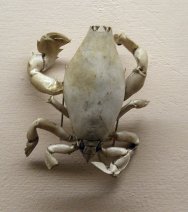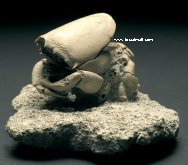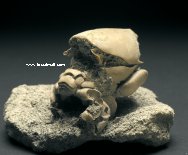|
|
High resolution
images above, other images below
|
Description:
I have come into possession of two specimens of this extraordinary
crab genus. It comes from one of the world’s foremost decapod
collections. To begin, this is not a composite. It is situated exactly
where it died and how it was fossilized after being painstakingly
curated from the matrix in which it became entombed. The specimen
is visually stunning, with the full carapace, both claws and many
of the legs are revealed; a testament to the art  of
fossil preparation. of
fossil preparation.
Raninidae
is an unusual crab family, taken by most scientists to be quite
primitive, and believed to be adapted to deep water. They are often
called frog crabs, the reasons for which are apparent in the extant
genus Lyreidus's carapace shown to the right. These animals closely
resemble the (unrelated) mole crabs, due to parallel evolution or
evolutionary relay. In both groups, the claws are modified into
tools for digging, and the body has a rounded shape that facilitates
burial in sand to hide from predators. Unlike most other true crabs,
the abdomens of raninids are not curled under the cephalothorax.
Please
access this on-line professional paper for more information concerning
this Ranilia species.
http://gsa.confex.com/gsa/2003SC/finalprogram/abstract_50074.htm
This
crab crawled the sea floor at around the same time as Homo habilis
walked the land. Crab fossil specialists will recognize this gem
as a unique opportunity. |




